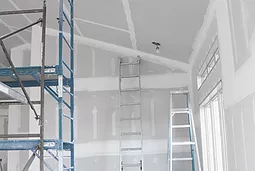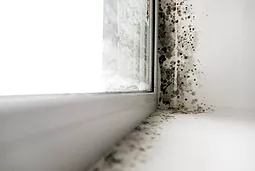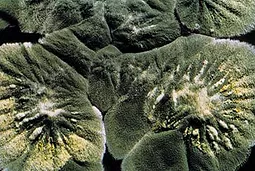Molds are a form of fungus. There are many different molds and they can be found both indoors and outdoors. Molds spread through the production of spores, which are present in all indoor environments and can not be removed from them. Spores are capable of surviving in harsh conditions that otherwise prevent the normal mold growth.
Molds grow best in moist, warm and humid environments – easily created in the home during the winter. When mold spores land on a damp spot they can begin to grow, digesting the material they are growing on as they do so. Molds are capable of growing on a variety of different surfaces, including fabric, paper and wood.
Common indoor molds include:
Molds take a variety of forms and textures, they can appear as white, black, yellow, blue or green and often looking like a discoloration or stain to a surface. They can also have a velvety, fuzzy or rough appearance, depending on the type of mold and where it is growing.

often found indoors growing on dust, powdery food items and building materials, such as drywall

found in damp places indoors, such as showers or under leaky sinks.

capable of growing in cool areas as well as warm ones. It is typically found on fabrics and wood surfaces

typically found on materials that have been damaged by water and often has a blue or green appearance.
Exposure to damp and moldy environments may cause a variety of health effects, or none at all. Some people are sensitive to molds. For these people, molds can cause nasal stuffiness, throat irritation, coughing or wheezing, eye irritation, or, in some cases, skin irritation. People with mold allergies may have more severe reactions. Immune-compromised people and people with chronic lung illnesses, such as obstructive lung disease, may get serious infections in their lungs when they are exposed to mold. These people should stay away from areas that are likely to have mold, such as compost piles, cut grass, and wooded areas.
In 2004 the Institute of Medicine (IOM) found there was sufficient evidence to link indoor exposure to mold with upper respiratory tract symptoms, cough, and wheeze in otherwise healthy people; with asthma symptoms in people with asthma; and with hypersensitivity pneumonitis in individuals susceptible to that immune-mediated condition. The IOM also found limited or suggestive evidence linking indoor mold exposure and respiratory illness in otherwise healthy children.
For more information about Mold please visit www.cdc.gov/mold/faqs.htm
As a TDSHS Mold Assessment Consultant, Abacus and can walk you through all the steps to fix your mold problem. We would start with a visual inspection, and we would take samples of the suspect material and have an NVLAP accredited lab test the material. If there is no visible mold, we would provide you with an air quality test to find out what is actually being breathed in at your residence or business. If mold is confirmed with either of these tests, Abacus would then provide you with a remediation plan.
Don’t end up spending more time and money than necessary. Abacus is a LICENSED Consultant Agency. Many other companies can only perform one type of inspection and are not there to help you through the rest of the process. Abacus Environment has 25+ years of experience and can not only perform inspections for you, but can provide you with remedial services throughout the entire process whether the project consists of Mold, Asbestos, or Lead-Based Paint.
© Copyright 2021 PIMM-USA. All Rights Reserved. | Website Design by WABW Media Group